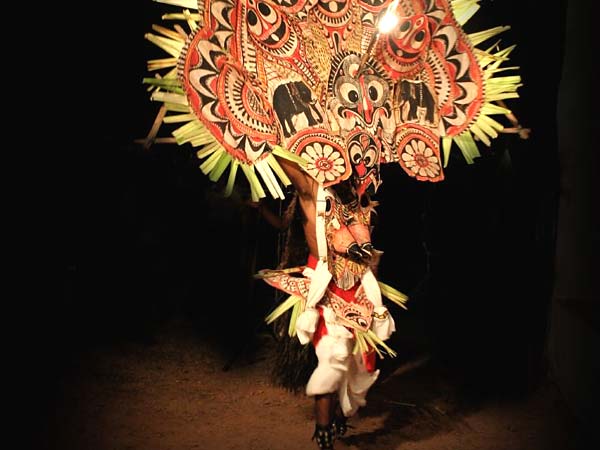South India brags of being the home to different folk dance forms. Check out the folk dances of Southern India.
Folk Dances of South India

India has a rich and varied collection of folk
dances. These dances have made great contribution in the development of
the classical dance forms of the country. They are less complex in
technique, than their classical counterparts, but do follow a broad set
of rules, which vary from one dance to another. Folk dances serve as an
important part of the life of many Indians, as entertainment options,
particularly those who live in the rural areas. There are so many folk
dances and their variations that can be found in India that trying to
count their number is almost impossible. However, we can broadly divide
them into seven regions, namely Central India, Eastern India, North East
India, Northern India, North West India, South India and South West
India. In this section, we would acquaint you with the popular folk
dances of South India.
Padayani or Paddeni (Kerala)
One of the most colorful and enchanting dances of Kerala, Padayani or
Paddeni is associated with the festivals of certain temples. These
temples are found in the districts of Alleppey, Quilon, Pathanamthitta
and Kottayam districts. The literal meaning of Padayani, in folk art, is
military formations or rows of army. It involves a series of divine and
semi divine impersonations The performers in Paddeni consist of dancers
or actors, singers (who recite different poems for different Kolams) and
instrumentalists (who play wild and loud rhythms on their drums called
thappu and cymbals).
Padayani dancers wear Kolams of different shapes, colors and designs,
painted on the stalks of areca nut fronds. Kolams are basically huge
headgears, with many projections and devices, having a mask for the face
and a piece to cover the chest and abdomen of the performer. The main
kolams (huge masks) used in Padayani are those of Bhairavi (Kali), Kalan
(god of death), Yakshi (fairy) and Pakshi (bird). One of the popular
Paddeni dances involve the dancers, singers and instrumentalists forming
a procession of Kali and her spirits, returning after the killing of the
'Asura' chief Darika.
Kummi and Kolattam (Tamil Nadu)
Kummi and Kolattam are the dances performed by the tribal women of
Tamil Nadu, during certain festivals. Kummi is a very simple form of
dance, where dancers form circles and clap as they dance. Kolattam is
also quite similar, the only difference being the use of small wooden
rods by the dancers. The dancers strike the rods in rhythm by, instead
of clapping, and provide the main tempo of the dance. The name Kolattam
has been derived from Kol (a small stick) and Attam (play), describing
its very nature. Kolattam is known by different names in different
states of India, such as stick dance, Kolannalu or Kolkolannalu. On an
average, a Kolattam dance group consists of 8 to 40 dancers.
Kargam and Puli Vesham (Tamil Nadu)
One of the most essential parts of a ritual dedicated to Mariamma, the
Goddess of Health and Rain, in the state of Tamil Nadu is the Kargam
dance. It is performed by men, wherein they balance pots, filled with
uncooked rice and surrounded by a tall conical bamboo frame covered with
flowers, on their head. Drums and long pipes form the musical
instruments that accompany the dance. Puli Vesham is another very
interesting dance of Tamil Nadu, which is performed by men during a
specific festival. In this dance form, the men disguise themselves in
tiger costumes and move around the streets.

